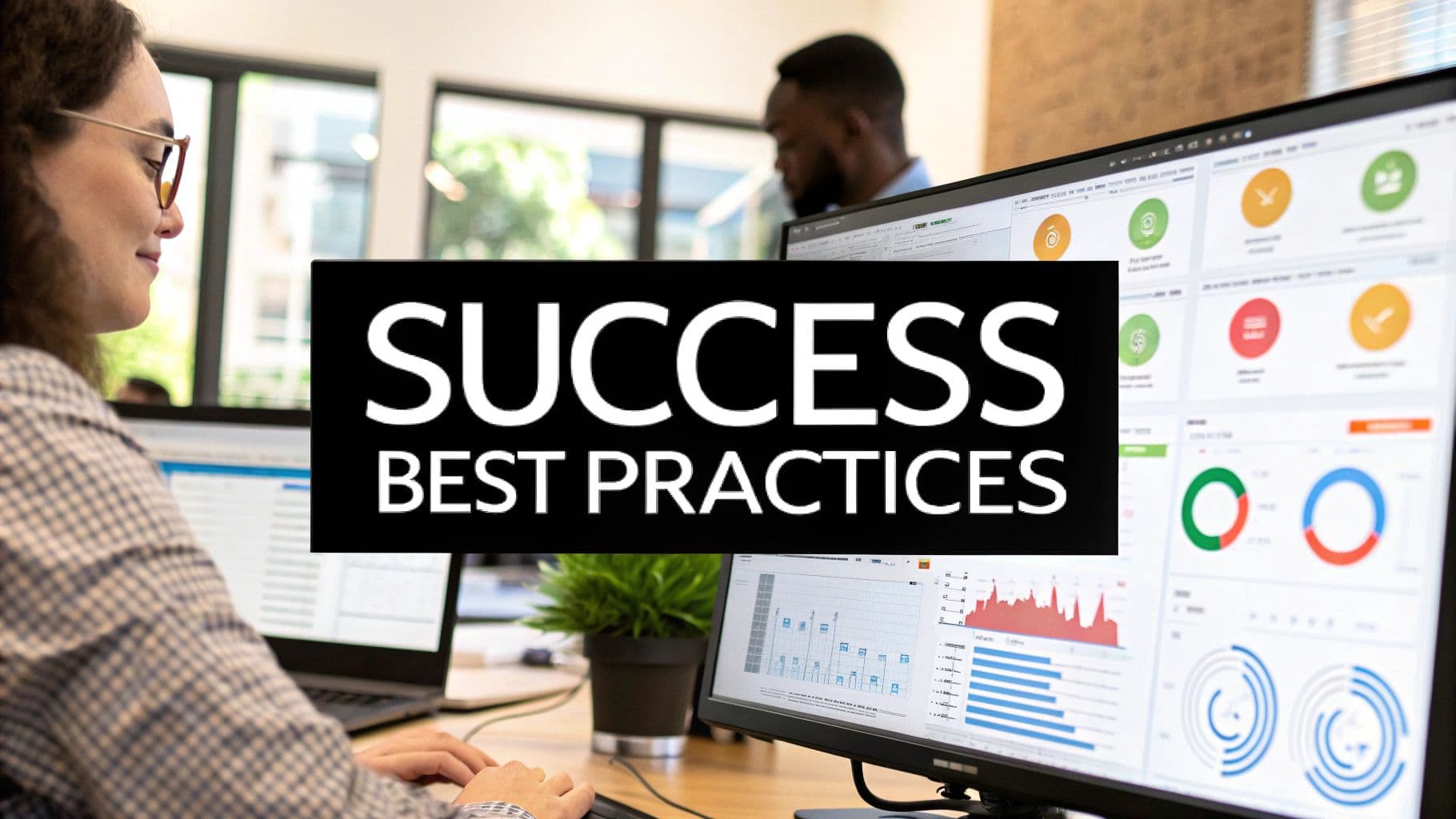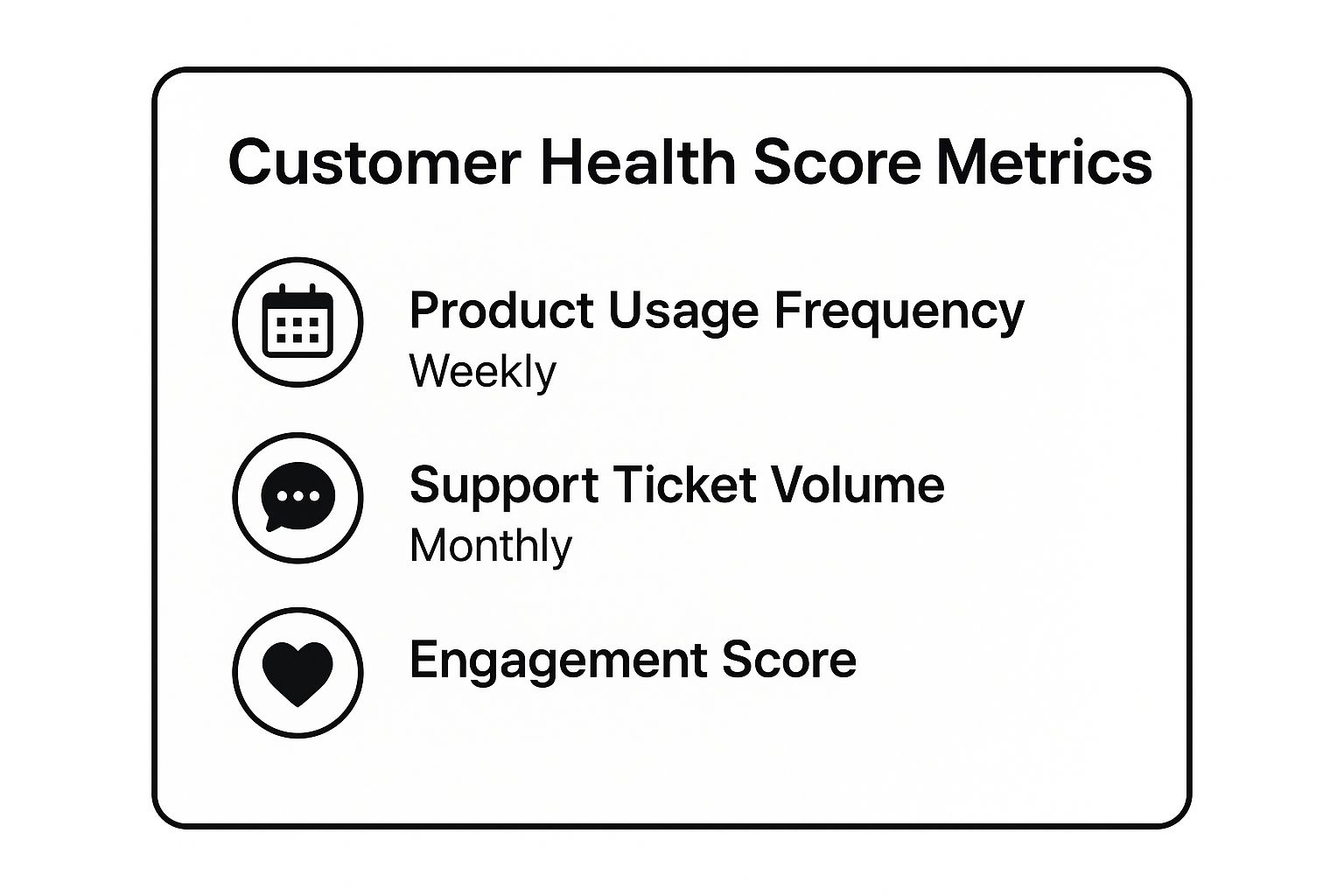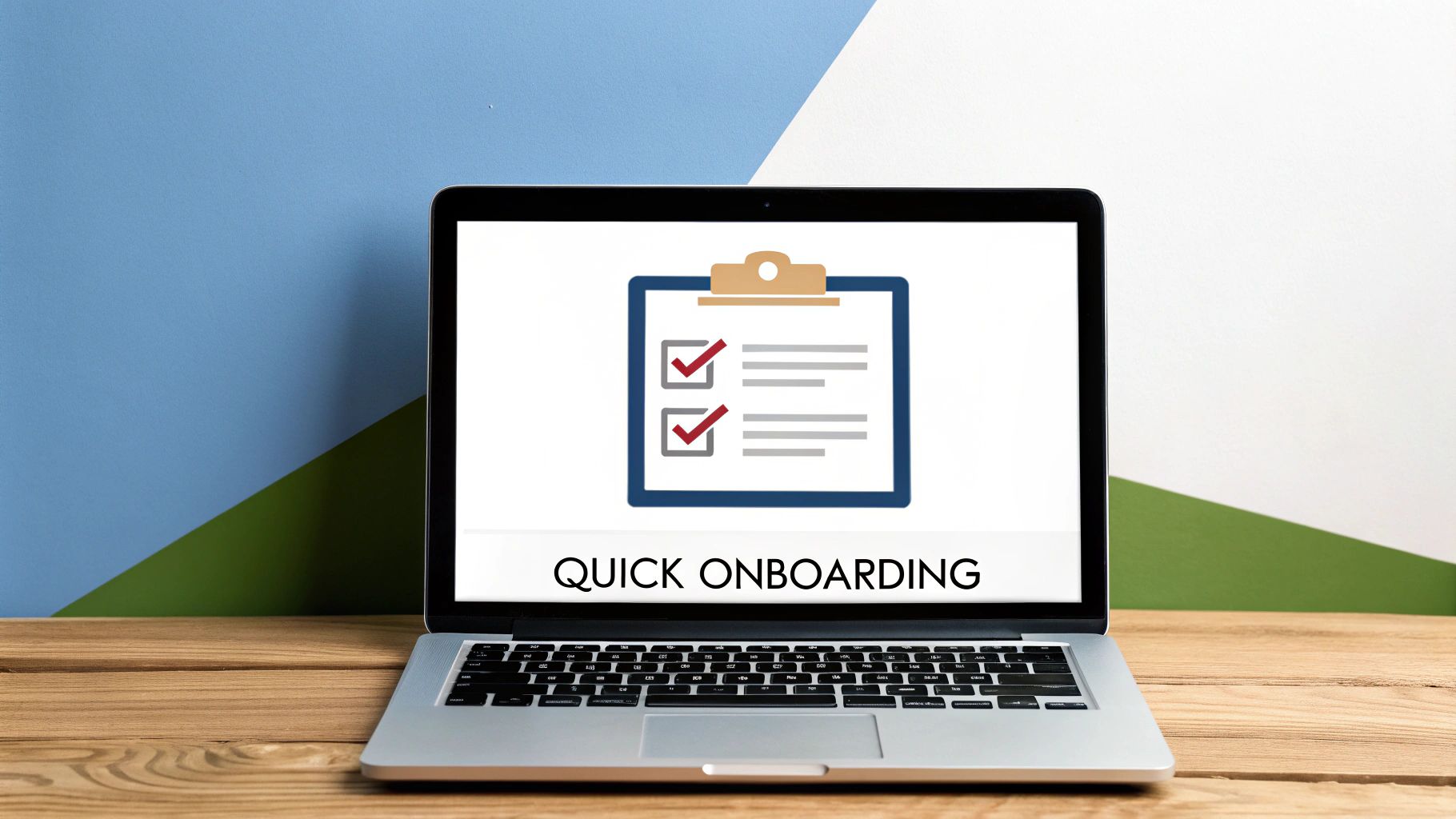9 Customer Success Best Practices for SaaS Teams in 2025
Discover 9 actionable customer success best practices to reduce churn and boost retention. Level up your SaaS strategy with expert tips and real-world examples.

Customer success is more than just support; it's the engine for sustainable SaaS growth. In a competitive market, simply reacting to problems is a recipe for churn. Proactive, data-driven strategies are essential to not only retain customers but also transform them into advocates who champion your product. The difference between a thriving SaaS business and a struggling one often comes down to a handful of critical customer success best practices.
This article cuts through the noise to deliver a comprehensive roundup of the most impactful strategies modern SaaS teams can implement immediately. We move beyond generic advice to provide a clear, actionable framework for building a world-class customer success program. You won't find vague theories here. Instead, you'll get detailed guidance on how to execute each practice effectively.
We will explore nine specific areas designed to turn your customer relationships into your most valuable asset. Prepare to learn how to:
- Monitor and act on customer health scores to preemptively address risks.
- Design proactive onboarding processes that ensure rapid time-to-value.
- Leverage customer feedback to directly influence product development.
- Implement data-driven metrics to prove the ROI of your success initiatives.
By the end of this guide, you will have a playbook of proven tactics for building a robust system that predicts customer needs, consistently proves value, and drives long-term, profitable loyalty. Let's dive into the essential best practices that define modern customer success.
1. Customer Health Score Monitoring
One of the most foundational customer success best practices is implementing a robust customer health scoring system. This proactive approach moves your team from a reactive, fire-fighting model to one that can predict and prevent churn. A customer health score is a metric that consolidates various data points into a single, understandable indicator of an account's well-being. It helps you gauge which customers are thriving, which are at risk, and which need immediate intervention.
The core idea is to quantify customer behavior and sentiment. By tracking product adoption, engagement levels, support ticket history, and even survey feedback, you create a holistic view of the customer relationship. For example, a customer who logs in daily but has a high volume of unresolved support tickets might be at a higher risk than one who logs in less frequently but utilizes key features effectively.
How to Implement Health Scoring
Getting started doesn't require a complex, multi-layered algorithm. In fact, it's best to start simple and refine over time. Focus on a few key metrics that directly correlate with customer value and retention.
- Product Usage: Track the frequency of logins, depth of feature adoption (are they using sticky features?), and session duration. This is often the most heavily weighted component.
- Support Interactions: Monitor the volume and severity of support tickets. A sudden spike can indicate frustration, while a lack of tickets for a new account could signal a lack of engagement.
- Customer Feedback: Incorporate data from NPS surveys, customer satisfaction (CSAT) scores, and direct feedback from check-in calls.
The following infographic highlights a few essential metrics that can form the basis of a powerful health score.

As visualized, blending these distinct data types provides a balanced and insightful view of an account's overall health. This system allows CSMs to prioritize their efforts, focusing on at-risk accounts before they become churn statistics and identifying healthy accounts for upsell opportunities. The ultimate goal is to create automated alerts that trigger playbooks when a score drops below a certain threshold, ensuring no customer slips through the cracks.
2. Proactive Customer Onboarding
First impressions are everything, and in SaaS, the onboarding process is your one chance to make a great one. Proactive customer onboarding is a structured, multi-touchpoint process designed to guide new customers from the initial sign-up to their first "aha moment" as quickly as possible. This approach is one of the most critical customer success best practices because it directly combats early-stage churn by demonstrating value and building momentum from day one. Instead of leaving users to figure things out on their own, it provides a clear, guided path to success.
The core objective is to reduce the time-to-value (TTV) and ensure users understand how your product solves their specific problems. A successful onboarding journey builds user confidence, promotes key feature adoption, and sets the foundation for a long-term, healthy customer relationship. For instance, Zoom's quick setup process gets users into their first meeting within minutes, delivering immediate value and solidifying its purpose.

How to Implement Proactive Onboarding
Creating an effective onboarding experience requires a strategic approach that blends in-app guidance, communication, and clear goal-setting. It's about progress, not perfection.
- Define "Aha Moments": Identify the key actions or outcomes that make a user realize your product's value. Design the entire onboarding flow to guide them to this milestone as efficiently as possible.
- Use Progressive Disclosure: Avoid overwhelming new users with every feature at once. Introduce functionality contextually, as they need it. Slack excels at this by gradually revealing advanced features as a team's usage grows.
- Implement Trigger-Based Communication: Move beyond simple time-based email sequences. Send messages based on user actions (or inaction). For example, if a user hasn't invited a teammate within 48 hours, trigger a helpful tip explaining the benefits of collaboration.
- Track and Optimize: Monitor completion rates for each step of your onboarding process. Identify where users are dropping off and experiment with changes to improve the flow and reduce friction.
By mastering proactive onboarding, you shift the customer journey from a passive experience to an active, value-driven partnership. This initial investment in user success pays long-term dividends in the form of higher retention, greater customer loyalty, and increased expansion revenue. It's a foundational practice for any SaaS business looking to scale sustainably.
3. Regular Business Reviews (QBRs/EBRs)
Another indispensable customer success best practice is establishing a cadence of regular business reviews, often called Quarterly Business Reviews (QBRs) or Executive Business Reviews (EBRs). These are not sales pitches; they are strategic, forward-looking meetings designed to reinforce the value your product delivers. These sessions provide a formal opportunity to review performance against goals, celebrate successes, address challenges, and strategically align on future objectives.
The primary goal is to shift the conversation from day-to-day tactical support to long-term strategic partnership. By demonstrating tangible ROI and discussing how your solution will continue to support the customer's evolving business needs, you solidify the relationship and proactively identify expansion opportunities. For instance, Salesforce's strategic account teams use these reviews to present industry benchmarks, helping clients see how they stack up against peers and plan for future growth.
How to Implement Business Reviews
Effective QBRs require diligent preparation and a customer-centric agenda. The focus should always be on the customer's outcomes, not your product's features. Start by defining which customer segments will receive QBRs, as they are typically reserved for high-value or strategic accounts.
- Lead with Value: Begin the meeting by highlighting key wins and ROI the customer has achieved since the last review. Use their own data and success metrics to tell a powerful story.
- Present Data-Driven Insights: Prepare detailed analytics on their product usage, adoption trends, and performance benchmarks. Show them how their usage compares to similar successful customers.
- Align on Future Goals: Discuss their upcoming business objectives and present a clear roadmap for how your product will support them. This is where you can organically introduce new features or services.
- Define Clear Action Items: Conclude with a summary of agreed-upon action items for both your team and the customer's. Follow up within 48 hours with a written recap to maintain momentum.
By consistently executing these strategic reviews, CSMs can prove ongoing value, strengthen executive relationships, and transition from being a vendor to an essential partner. This proactive engagement is a cornerstone of world-class customer success, directly combating churn and uncovering new avenues for revenue growth.
4. Customer Success-Driven Product Development
An often-overlooked yet powerful customer success best practice is to create a direct feedback loop between your customer success (CS) team and your product development team. This collaborative approach ensures that the product roadmap is not built in a vacuum but is directly informed by the real-world needs, pain points, and usage patterns of your actual customers. It transforms your CS team from a reactive support function into a strategic partner in product innovation.
The core principle is to systematically channel customer insights from the front lines to the people building the product. When CSMs share common feature requests, points of friction, and workflow challenges, the product team gains an invaluable source of qualitative data. For instance, Atlassian's customer advisory boards directly influence the roadmaps for Jira and Confluence, ensuring new features solve tangible problems for their power users. This alignment helps reduce churn by building a product that customers genuinely want and need.
How to Implement a CS-Driven Feedback Loop
Creating a formal process is key to moving beyond ad-hoc conversations. A structured system ensures that valuable feedback is captured, prioritized, and acted upon, making customers feel heard and valued.
- Structured Feedback Collection: Implement a dedicated channel for CSMs to submit feedback, such as a specific Slack channel, a form, or a tag in your CRM. Each submission should include the customer's name, the problem they are facing, and the potential business impact of a solution.
- Prioritize with Data: Use a framework to evaluate requests based on factors like the number of customers requesting the feature, the potential revenue impact (e.g., requested by high-value accounts), and alignment with the overall product vision.
- Close the Loop: This is a critical step. When a feature requested by a customer is released, empower the CSM to communicate this update back to them personally. This simple action demonstrates that you listen and reinforces the value of their partnership.
By embedding customer success insights into your development cycle, you build a stickier, more user-centric product. This strategy not only improves customer satisfaction but also provides a significant competitive advantage. For those looking to refine their strategy, it is helpful to learn more about how a product development roadmap can be shaped by customer feedback. This proactive approach ensures your product evolves in lockstep with the needs of your most important asset: your customers.
5. Customer Segmentation and Personalization
A one-size-fits-all approach to customer success is a recipe for inefficiency and disengagement. Implementing customer segmentation and personalization is one of the most critical customer success best practices for scaling your efforts effectively. This involves dividing your customer base into distinct groups based on shared characteristics and tailoring your engagement strategies to meet the unique needs of each segment. This ensures that every customer receives relevant, valuable support that aligns with their specific goals.
The core idea is to move beyond generic interactions and deliver a bespoke experience. By grouping customers by factors like company size, industry, product usage patterns, or desired outcomes, you can create targeted playbooks, communication cadences, and resource allocation models. For example, a high-touch approach with dedicated CSMs might be reserved for enterprise accounts, while a tech-touch model leveraging automated onboarding and a rich knowledge base might be perfect for SMB customers.

How to Implement Segmentation
Effective segmentation doesn't have to be overly complex from the start. The key is to begin with broad, meaningful categories and refine them as you gather more data and insights about your customer base.
- Firmographics: Group customers by easily identifiable data like company size (employee count, ARR), industry, or geographic location. This is often the simplest and most common starting point.
- Behavioral Data: Segment based on how customers interact with your product. This includes their adoption level of key features, login frequency, support ticket volume, or health score.
- Needs-Based: Group customers by the specific goals or "jobs-to-be-done" they are trying to accomplish with your product. For instance, Adobe segments Creative Cloud users into categories like photographers, designers, and video editors, each with distinct needs.
As illustrated, a well-defined segmentation strategy enables your team to focus its energy where it will have the greatest impact. It allows for proactive, relevant outreach that speaks directly to a customer's business context, preventing churn by addressing their specific challenges. Ultimately, this practice transforms your customer success function from a generic support center into a strategic partner invested in the unique success of every customer segment.
6. Continuous Customer Education and Training
A key pillar of proactive customer success best practices is establishing a program for continuous customer education and training. Instead of viewing training as a one-time onboarding event, this approach provides customers with ongoing resources to deepen their product knowledge and achieve their business goals. An educated customer is an empowered customer, one who can independently solve problems, discover new value in your platform, and become a true product champion.
This strategy goes beyond a simple knowledge base. It involves creating a structured learning ecosystem that helps users master your product over their entire lifecycle. By offering everything from self-service tutorials to formal certification programs, you reduce the burden on your support team and increase product stickiness. For instance, well-educated users are more likely to adopt advanced features, integrate your product deeper into their workflows, and ultimately see a greater return on their investment, which directly correlates with retention and expansion.
How to Implement Continuous Education
Building a successful education program requires a multi-faceted approach that caters to different learning styles and levels of expertise. Start by identifying the most common challenges and desired outcomes for your customers.
- Develop a Content Hub: Create a centralized location for all learning materials. This can include video tutorials, in-depth guides, webinars, and best practice articles. Platforms like HubSpot Academy and Salesforce Trailhead have set the gold standard by offering comprehensive, free education that also serves as a powerful marketing tool.
- Leverage In-App Guidance: Use tooltips, walkthroughs, and modals to deliver bite-sized training directly within your application. This contextual learning helps users discover relevant features at the exact moment they need them, improving adoption without disrupting their workflow.
- Create Structured Learning Paths: Organize content into logical courses or "paths" that guide users from beginner to expert. Gamification elements, like badges and certifications offered by Salesforce Trailhead, can significantly boost engagement and motivate users to complete the training.
By investing in continuous education, you empower customers to maximize the value they get from your product. This not only improves their satisfaction and loyalty but also positions your company as a thought leader in your industry. An effective training program transforms your product from a simple tool into an indispensable solution, creating a powerful moat against competitors.
7. Customer Feedback Loop Implementation
One of the most impactful customer success best practices is establishing a systematic customer feedback loop. This goes beyond simply collecting survey responses; it involves creating a structured process to collect, analyze, route, and act on customer insights. A closed-loop system ensures that customer voices don't disappear into a black hole but instead directly inform product development, process improvements, and overall business strategy.
The core principle is to make feedback an active, two-way conversation. When customers see their suggestions lead to tangible changes, it builds immense loyalty and makes them feel like valued partners in your company's journey. For instance, Buffer's transparent roadmap, which often incorporates user feedback, and Spotify's algorithm refinements based on listening behavior are prime examples of this practice in action, turning feedback into a competitive advantage.
How to Implement a Feedback Loop
Creating an effective feedback loop requires a commitment to action, not just collection. The goal is to make the process repeatable, scalable, and integrated into your team's daily workflows. Start by focusing on key touchpoints in the customer journey.
- Systematic Collection: Set up automated feedback requests at crucial moments, such as after onboarding is complete, a support ticket is resolved, or a key feature is used for the first time. Use a mix of NPS, CSAT, and open-ended questions.
- Centralize and Analyze: Funnel all feedback into a single system for analysis. Create a standardized process for tagging and categorizing feedback by theme (e.g., UI/UX, feature request, bug report) to identify trends. To streamline this, you can learn more about the various customer feedback analysis tools on sigos.io.
- Act and Communicate: Most importantly, close the loop. Route insights to the relevant teams (product, engineering, marketing) for action. Communicate back to the customers who provided the feedback, letting them know what changes were made as a result. This final step is what transforms data collection into a powerful relationship-building tool.
8. Cross-Functional Customer Success Teams
One of the most transformative customer success best practices is to break down internal silos and foster cross-functional collaboration. Customer success is not the sole responsibility of a single department; it's a company-wide philosophy. This approach involves creating an organizational structure where representatives from success, sales, marketing, product, and support work together toward shared customer outcomes. This ensures a seamless and aligned customer experience at every touchpoint.
The core principle is that a customer's journey is not linear and doesn't fit neatly into one department's purview. When a product bug reported to support is also visible to the product team, and the CSM understands the marketing promises made during the sales cycle, the company can act as a unified entity. This integrated approach, seen in customer-centric companies like Slack, where engineering and CS teams collaborate closely, prevents conflicting messages and ensures customer needs directly influence product development and company strategy.
How to Foster Cross-Functional Collaboration
Building a truly integrated team requires intentional effort and structural changes. It’s about creating systems that encourage and reward collective ownership of the customer experience.
- Create Shared Metrics: Align incentives across departments with shared goals. For example, tie a portion of the product team's bonus to a reduction in feature-related support tickets or an increase in feature adoption rates, metrics that the CS team also tracks.
- Implement Regular Cross-Functional Meetings: Schedule recurring "Voice of the Customer" meetings where representatives from different teams review customer feedback, analyze health scores, and collaboratively strategize on at-risk or expansion accounts.
- Establish Clear Roles and Responsibilities: While encouraging collaboration, it’s crucial to define who owns what. Use a RACI (Responsible, Accountable, Consulted, Informed) chart for key customer-facing processes to avoid confusion and ensure accountability.
- Use Collaborative Tools: Invest in a shared platform, like a CRM or customer success platform, that gives every department a unified view of all customer interactions, from sales notes and support tickets to product usage data and marketing engagement.
By embedding customer-centricity into the fabric of your organization, you move beyond simply having a customer success team to becoming a customer success-driven company. This holistic strategy is fundamental for long-term retention and sustainable growth.
9. Data-Driven Customer Success Metrics
Moving beyond intuition is a critical step in maturing a customer success function. This is where implementing data-driven customer success metrics becomes one of the most vital best practices. This approach involves the systematic tracking and analysis of key performance indicators (KPIs) to measure customer health, satisfaction, and overall business impact. It shifts the team's focus to evidence-based decision-making for every strategic initiative.
By establishing a clear set of metrics, you create a universal language for understanding customer value and risk across the organization. For example, Netflix doesn't just guess which shows are popular; it uses sophisticated viewer engagement and retention analytics to inform content decisions. Similarly, a data-driven customer success team can pinpoint which actions directly lead to higher retention, expansion revenue, and customer advocacy, allowing them to scale their impact effectively.
How to Implement Data-Driven Metrics
To successfully leverage data, you must choose metrics that truly reflect customer value and align with your business goals. Start by identifying the key outcomes you want to drive and then work backward to select the corresponding KPIs.
- Balance Indicators: It's crucial to track both leading indicators (like product usage and feature adoption rates) that predict future outcomes and lagging indicators (like net revenue retention and churn rate) that measure past performance. This combination provides a complete picture of your customer base's health.
- Establish Baselines: Before launching a new onboarding program or engagement campaign, measure your current state. Establishing baseline measurements allows you to accurately quantify the impact of your initiatives and prove the ROI of your team's efforts.
- Automate Reporting: Manual data pulling is inefficient and prone to errors. Create automated dashboards and reports to ensure consistent, real-time tracking of your core metrics. This frees up CSMs to focus on strategic activities rather than administrative tasks.
- Regularly Validate: Periodically review whether your chosen metrics still align with actual customer success outcomes. A metric that seemed important a year ago might no longer be the best indicator of a healthy customer relationship.
By focusing on the right data, teams can transform their operations from reactive problem-solving to proactive, strategic management of the customer lifecycle. A deep understanding of these KPIs is fundamental for predicting churn and identifying growth opportunities. To explore this topic further, you can learn more about key user retention metrics and how to track them effectively. This quantitative approach ensures your customer success best practices are not just well-intentioned but also demonstrably effective.
9 Key Customer Success Practices Comparison
| Item | Implementation Complexity 🔄 | Resource Requirements ⚡ | Expected Outcomes 📊 | Ideal Use Cases 💡 | Key Advantages ⭐ |
|---|---|---|---|---|---|
| Customer Health Score Monitoring | High - setup and calibration needed | High - data infrastructure and tools | Proactive churn identification, prioritized success | Companies needing early risk detection, SaaS with rich data | Early issue detection, data-driven management |
| Proactive Customer Onboarding | Medium-High - multi-touchpoint design | Medium-High - content, automation | Reduced early churn, faster time-to-value | New customer activation, complex products requiring guidance | Accelerates adoption, improves retention |
| Regular Business Reviews (QBRs) | Medium - requires preparation and skills | Medium - executive involvement | Strengthened relationships, expansion opportunities | Strategic accounts, enterprise customers | Builds executive trust, uncovers upsell chances |
| Customer Success-Driven Product Development | Medium - ongoing collaboration | Medium - cross-team coordination | Better product-market fit, reduced support calls | Product-led companies, SaaS platforms | Aligns product to customer needs, increases satisfaction |
| Customer Segmentation and Personalization | High - complex segmentation and maintenance | High - data collection and tooling | More relevant interactions, efficient resource use | Diverse customer base with varying needs | Improves engagement, customizes experience |
| Continuous Customer Education & Training | Medium - content creation and updates | Medium-High - training materials | Increased adoption, reduced support tickets | Products with steep learning curve, feature-rich offerings | Boosts confidence, enables self-service |
| Customer Feedback Loop Implementation | Medium - setup of feedback systems | Medium - tools and analysis effort | Insight-driven improvements, increased trust | Customer-centric businesses requiring continuous feedback | Direct customer insights, drives innovation |
| Cross-Functional Customer Success Teams | High - organizational and cultural change | High - coordination and leadership | Unified customer experience, faster resolution | Companies overcoming siloed structures | Breaks silos, leverages collective expertise |
| Data-Driven Customer Success Metrics | High - data infrastructure and analytics | High - BI tools and expertise | Evidence-based decisions, ROI demonstration | Data-focused organizations, those scaling customer success | Objective metrics, predictive insights |
Activating Your Customer Success Flywheel
Navigating the landscape of customer success can feel like juggling multiple high-stakes initiatives at once. We've explored a comprehensive set of customer success best practices, from establishing robust Customer Health Score Monitoring to fostering Cross-Functional Customer Success Teams. Each practice we've detailed, whether it's the strategic cadence of Quarterly Business Reviews or the crucial implementation of a Customer Feedback Loop, serves as a vital component in a much larger, more dynamic system.
The core takeaway is that these strategies are not isolated tactics to be checked off a list. Instead, they are interconnected gears in a powerful engine. Exceptional Proactive Customer Onboarding directly impacts initial health scores and sets the stage for future engagement. The insights gathered from Continuous Customer Education and Training sessions inform the Customer Segmentation and Personalization strategies that make every interaction feel relevant and valuable. This interconnectedness creates a self-reinforcing cycle, a flywheel that, once in motion, generates its own momentum.
From Individual Practices to a Unified Strategy
The true power of these customer success best practices is unlocked when they are integrated into a cohesive, data-driven strategy. Think of it this way:
- Data as the Foundation: Your Data-Driven Customer Success Metrics are the bedrock. They provide the objective truth about customer health, engagement, and satisfaction, removing guesswork from your operations.
- Proactive Engagement as the Accelerator: Practices like proactive onboarding, regular business reviews, and continuous education are the actions that push the flywheel forward. They prevent churn before it starts and identify expansion opportunities before they become obvious.
- Feedback as the Steering Mechanism: The Customer Feedback Loop and Customer Success-Driven Product Development ensure your flywheel is moving in the right direction. This continuous stream of insight from your user base keeps your product roadmap aligned with real-world needs, ensuring long-term value and loyalty.
When these elements work in concert, the results are transformative. Successful customers don't just renew; they become your most effective marketing channel. They provide testimonials, participate in case studies, refer new business, and offer the invaluable product feedback that fuels your next wave of innovation. This is the essence of the customer success flywheel: a sustainable, scalable growth model powered by the success of the people you serve.
Your Actionable Path Forward
Implementing all nine of these practices overnight is an unrealistic goal. The key is to start with a focused, strategic approach. Begin by identifying the one or two areas that represent the biggest friction point or opportunity for your customers right now.
- Assess Your Current State: Where are you seeing the most churn? Is it during onboarding? Are customers failing to adopt key features? Use your existing data to pinpoint the most critical area for improvement.
- Choose Your Starting Point: If early churn is high, focus relentlessly on perfecting Proactive Customer Onboarding. If you lack a clear understanding of customer sentiment, prioritize implementing a robust Customer Feedback Loop.
- Measure and Iterate: As you implement a new practice, define the key metrics you will use to measure its success. Track your progress, gather feedback on the process itself, and refine your approach continuously.
This iterative process builds momentum. As you master one practice, you'll find it naturally supports and enhances the next. By focusing on incremental, high-impact improvements, you gradually build the comprehensive, world-class customer success program that turns customers into lifelong advocates. This journey transforms customer success from a reactive support function into the central revenue and growth engine of your entire organization.
Ready to turn customer conversations into your most valuable data source? SigOS uses advanced AI to analyze support tickets, calls, and reviews, automatically identifying critical product issues and high-impact feature requests. Stop guessing and start prioritizing with data-driven insights. Discover how SigOS can activate your customer success flywheel today.
Keep Reading
More insights from our blog


